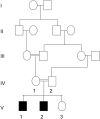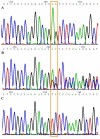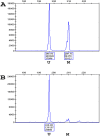Germline mutation in NLRP2 (NALP2) in a familial imprinting disorder (Beckwith-Wiedemann Syndrome)
- PMID: 19300480
- PMCID: PMC2650258
- DOI: 10.1371/journal.pgen.1000423
Germline mutation in NLRP2 (NALP2) in a familial imprinting disorder (Beckwith-Wiedemann Syndrome)
Abstract
Beckwith-Wiedemann syndrome (BWS) is a fetal overgrowth and human imprinting disorder resulting from the deregulation of a number of genes, including IGF2 and CDKN1C, in the imprinted gene cluster on chromosome 11p15.5. Most cases are sporadic and result from epimutations at either of the two 11p15.5 imprinting centres (IC1 and IC2). However, rare familial cases may be associated with germline 11p15.5 deletions causing abnormal imprinting in cis. We report a family with BWS and an IC2 epimutation in which affected siblings had inherited different parental 11p15.5 alleles excluding an in cis mechanism. Using a positional-candidate gene approach, we found that the mother was homozygous for a frameshift mutation in exon 6 of NLRP2. While germline mutations in NLRP7 have previously been associated with familial hydatidiform mole, this is the first description of NLRP2 mutation in human disease and the first report of a trans mechanism for disordered imprinting in BWS. These observations are consistent with the hypothesis that NLRP2 has a previously unrecognised role in establishing or maintaining genomic imprinting in humans.
Conflict of interest statement
The authors have declared that no competing interests exist.
Figures



References
-
- Charalambous M, da Rocha ST, Ferguson-Smith AC. Genomic imprinting, growth control and the allocation of nutritional resources: consequences for postnatal life. Curr Opin Endocrinol Diabetes Obes. 2007;14:3–12. - PubMed
-
- Cooper WN, Luharia A, Evans GA, Raza H, Haire AC, et al. Molecular subtypes and phenotypic expression of Beckwith-Wiedemann syndrome. Eur J Hum Genet. 2005;13:1025–1032. - PubMed
Publication types
MeSH terms
Substances
Grants and funding
LinkOut - more resources
Full Text Sources
Miscellaneous

